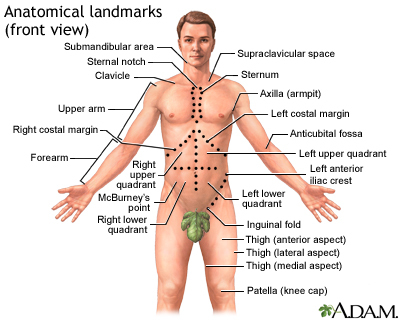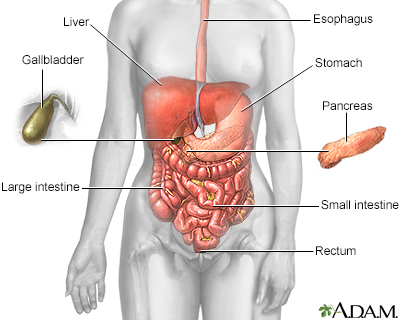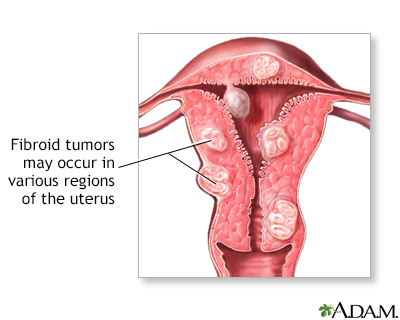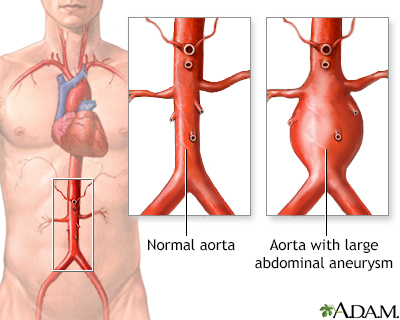Abdominal mass
Definition
An abdominal mass is swelling in one part of the belly area (abdomen).
Alternative Names
Mass in the abdomen
Considerations
An abdominal mass is most often found during a routine physical exam. Most of the time, the mass develops slowly. You may not be able to feel the mass.
Locating the pain helps your health care provider make a diagnosis. For example, the abdomen can be divided into four areas:
- Right-upper quadrant
- Left-upper quadrant
- Right-lower quadrant
- Left-lower quadrant

Other terms used to find the location of abdominal pain or masses include:
- Epigastric -- center of the abdomen just below the rib cage
- Periumbilical -- area around the belly button
The location of the mass and its firmness, texture, and other qualities can provide clues to its cause.
Causes
Several conditions can cause an abdominal mass:
- Abdominal aortic aneurysm can cause a pulsating mass around the navel.
- Bladder distention (urinary bladder over-filled with fluid) can cause a firm mass in the center of the lower abdomen above the pelvic bones. In extreme cases, it can reach as far up as the navel.
- Cholecystitis can cause a very tender mass that is felt below the liver in the right-upper quadrant (occasionally).
- Colon cancer can cause a mass almost anywhere in the abdomen.
- Crohn disease or bowel obstruction can cause many tender, sausage-shaped masses anywhere in the abdomen.
- Diverticulitis can cause a mass that is usually located in the left-lower quadrant.
- Gallbladder tumor can cause a tender, irregularly shaped mass in the right-upper quadrant.
- Hydronephrosis (fluid-filled kidney) can cause a smooth, spongy-feeling mass in one or both sides or toward the back (flank area).
- Kidney cancer can sometimes cause a mass in the abdomen.
- Liver cancer can cause a firm, lumpy mass in the right upper quadrant.
- Liver enlargement (hepatomegaly) can cause a firm, irregular mass below the right rib cage, or on the left side in the stomach area.
- Neuroblastoma, a cancerous tumor often found in the lower abdomen can cause a mass (this cancer mainly occurs in children and infants).
- Ovarian cyst can cause a smooth, rounded, rubbery mass above the pelvis in the lower abdomen.
- Pancreatic abscess can cause a mass in the upper abdomen in the epigastric area.
- Pancreatic pseudocyst can cause a lumpy mass in the upper abdomen in the epigastric area.
- Renal cell carcinoma can cause a smooth, firm, but not tender mass near the kidney (usually only affects one kidney).
- Spleen enlargement (splenomegaly) can sometimes be felt in the left-upper quadrant.
- Stomach cancer can cause a mass in the left-upper abdomen in the stomach area (epigastric) if the cancer is large.
- Uterine leiomyoma (fibroids) can cause a round, lumpy mass above the pelvis in the lower abdomen (sometimes can be felt if the fibroids are large).
- Volvulus can cause a mass anywhere in the abdomen.
- Ureteropelvic junction obstruction can cause a mass in the lower abdomen.
Home Care
All abdominal masses should be examined as soon as possible by the provider.
Changing your body position may help relieve pain due to an abdominal mass.
When to Contact a Medical Professional
Get medical help right away if you have a pulsating lump in your abdomen along with severe abdominal pain. This could be a sign of a ruptured aortic aneurysm, which is an emergency condition.
Contact your provider if you notice any type of abdominal mass.
What to Expect at Your Office Visit
In nonemergency situations, your provider will perform a physical exam and ask questions about your symptoms and medical history.
In an emergency situation, you will be stabilized first. Then, your provider will examine your abdomen and ask questions about your symptoms and medical history, such as:
- Where is the mass located?
- When did you notice the mass?
- Does it come and go?
- Has the mass changed in size or position? Has it become more or less painful?
- What other symptoms do you have?
A pelvic or rectal exam may be needed in some cases. Tests that may be done to find the cause of an abdominal mass include:
- Abdominal CT scan
- Abdominal ultrasound
- Abdominal x-ray
- Angiography
- Barium enema
- Blood tests such as CBC and blood chemistry
- Colonoscopy
- EGD
- Isotope study
- Sigmoidoscopy
Gallery




References
Ball JW, Dains JE, Flynn JA, Solomon BS, Stewart RW. Abdomen. In: Ball JW, Dains JE, Flynn JA, Solomon BS, Stewart RW, eds. Seidel's Guide to Physical Examination. 9th ed. St Louis, MO: Elsevier; 2019:chap 18.
Landmann A, Bonds M, Postier R. Acute abdomen. In: Townsend CM Jr, Beauchamp RD, Evers BM, Mattox KL, eds. Sabiston Textbook of Surgery. 21st ed. St Louis, MO: Elsevier; 2022:chap 46.
McQuaid KR. Approach to the patient with gastrointestinal disease. In: Goldman L, Schafer AI, eds. Goldman-Cecil Medicine. 26th ed. Philadelphia, PA: Elsevier; 2020:chap 123.
